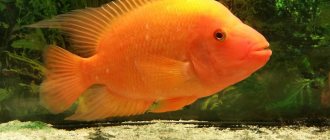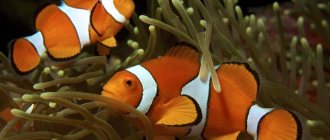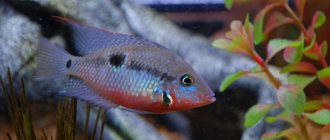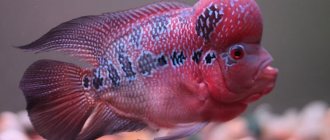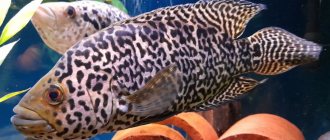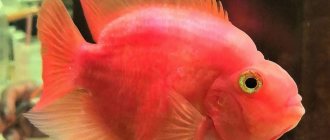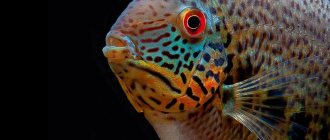Peculiar features of tilapia
- Reacts to the owner and becomes attached to him, swims up during feeding and shows his friendly attitude in every possible way;
- loves to dig and burrow into the ground, pull out plants;
- during spawning, females acquire an amazing silvery-brown hue with dark spots on the sides;
- some species are prone to hermaphroditism;
- Nile controls the number of malaria mosquitoes in the area
- Mozambican helps in the fight against filamentous algae
Currently, the fish is widely popular throughout the world due to its ease of breeding and remarkable habits. Animal psychologists and underwater acoustics specialists are seriously studying the conditioned reflexes of this fish, which resemble those of a dog.
Description of the genus “NEOLAMPROLOGUS (Neolawprologus)”
Order: Perciformes Suborder: Perciformes Family: Cichlidae
They inhabit the lake. Tanganyika.
The body is more or less elongated in length, flattened laterally, the profile of the back is somewhat more curved than the belly. The head is small, the lips are thick. The dorsal fin is long, almost uniform in height.
Species spawning in the cave stay in the lower and middle layers of water. Males form a territory and behave with varying degrees of aggressiveness. In some cases, the territory may extend over the entire aquarium and then you only have to keep a couple of fish. It is not recommended to separate couples. In an aquarium with a length of 120 cm, together with neolamprologus, you can keep fish of the family inhabiting the lake. Tanganyika and spawning in caves (5-6 species), in which, along with a sufficient number of structures made of stones imitating rocks with caves and crevices, thickets of plants with a powerful root system that form the boundaries of the territories should be provided. After the formation of pairs on the juvenile fish, the rest should be removed.
Water for keeping: 24-27°C, dH 7-20°, pH 7.4-8.5.
Food: live, substitutes.
The eggs are laid in a cave, sometimes on a rock. Typically, the female cares for the eggs, while the male guards the territory. Spawning is stimulated by a 2°C increase in temperature and fresh water.
From the editor: Key mossThe incubation period is 2-3 days, the fry swim in 6-10 days.
Starter food: rotifers, cyclops nauplii and brine shrimp.
Adult fish do not touch the fry, which at first stay in their territory.
Puberty at 8-12 months.
Other species of the genus:
- Princess of Burundi (Neolamprologus brichardi)
- Lamprlogus orange. Citron lamprologus (Neolamprologus leleupi)
- Neolamprologus tetracanthus
- Lamprologus meeli (Neolamprologus meeli)
- Neolamprologus brevis
- Neolamprologus ocellatus
Planet TANGANYIKA
Telmatochromis vittatus was scientifically described by George Boulanger more than a century ago. A noticeable feature of the appearance of this small cichlid is its highly elongated, somewhat rocker-shaped body with a small head and a pair of black longitudinal stripes. One, starting on the upper lip, stretches across the entire body to the caudal fin. The other is shorter and follows the dorsal ridge to the end of the dorsal fin. The fins of vittatus are framed by a thin blue border with a black trim.
One and a half year old male Telmatochromis vittatus. You can clearly see how much sharper and longer the ends of the dorsal, anal and ventral fins are than those of the female in the photo below:
A glimpse of Telmatochromis vittatus evokes associations with julidochromis. Indeed, the appearance of these cichlids has many similarities, but only at first glance. It is enough to look at the vitatus a little more closely, for example from above, to detect significant differences. The body of Telmatochromis is not cylindrical, but strongly flattened laterally, having a ribbon-like shape. Their amazing plasticity is associated with this. Vitatus are capable of bending into the most bizarre zigzags, hooks and brackets that other Tanganyikan cichlids have never dreamed of. Fish are especially zealous in this, naturally, during the mating season.
My aged, “best seen” vittatus reached a length of up to 8.5 cm, females were about one and a half centimeters smaller than them in size. The differences in young producers are not so striking; they are more noticeable in older specimens. The large, lean male makes an impression with his special “moray eel-like” appearance. In the “veteran”, the ends of the dorsal and anal fins are long and pointed, and the first ray of the pelvic fins is extended into a peak. The male is larger and more massive than the female, which has modest fins and a slightly more convex abdominal line. The body of vitatus is covered with very small scales and is very soft to the touch. I paid attention to this when I picked up fish that accidentally fell on the floor, although this species does not belong to “jumpers”. It turned out to be difficult to lift; not only is the flat body impossible to pick up, it is very slippery due to the abundant mucus covering it.
Separately, I would like to say about the life expectancy of these “spineless” cichlids. The topic is traditionally vague, the available data is always approximate, and the more important is any “notch” on this topic. I never kept records, but the vitatus “arrived” to me on the eve of 2006, and therefore I remember that day very well. It's nice to give yourself a gift for the New Year. From a group of young fish, a harem of a male and three females “crystallized” and lasted for almost 9 years. Fish farmers, as a rule, are more interested in the reproductive period of life, and so the activity of the Wittatus in this matter remained until the end. I think Telmatochromis would have lived longer if your humble servant had not decided to arrange a change of scenery in the aquarium.
Well-reared mature females lay an average of 50 eggs per spawning; the “youth” have more modest results. The eggs for substrate-laying cichlids are large in Vitatus, like in Altolamprologus
Telmatochromis vittatus and a number of similar long-bodied fellows are probably the most peaceful and calm Lamprologini. Even miniature shell lamprologus are an order of magnitude more unyielding in territorial matters. Their level of tolerance, in my opinion, is close to absolutely neutral in the interspecies relations of Xenotilapia. They will not fight back against a “tough” enemy, and why should they? This is not “their method”.
They will prefer to give way (in the photo on the right - the “siege” did not last long). The “life credo” of the Wittatus is to adapt to living everywhere and avoid conflicts. Remaining “in the background,” they manage to coexist well with a variety of neighbors, sometimes much harsher than this star-shaped neighbor on the right. Unconditional dominants get used to the submissiveness of vittatuses and do not see them as rivals. Long-bodied animals do not particularly react with hostility to even outright “trifles”, with the possible exception of the closest approaches to the nest. If the enemy is stronger, the male will try to lead him away from the nest or will simply swim away, and the female will hide so deeply into the spiral of the shell that the “aggressor” will not even understand that she is there.
For the nest, the female will choose the most inaccessible cavity; it is good if the entrance to it is narrower. Its body, flexible as a rope, allows it to turn around in the smallest shelter, from where, slightly sticking its head out, it is very convenient to carry out “monitoring.” After spawning, the female stays close to the clutch; sometimes you can see her swaying, fanning the clutch with her fins. During the spawning period, the habits of Vitatus reminded me of large lamprologus. Here there are “falling prostrate” in front of the partner (flat on the ground), and sharp throws at the nest in order to “plant” the female on it, and “male distrust”... True, the mating season here goes without sharp attacks against anyone. After spawning, the male can swim anywhere, but periodically visits the nest “for inspection.” He climbs in rather unceremoniously, squeezes into the female’s hole, and, making sure that everything is in order there, swims out. This happens many times a day. The disappearance of masonry almost always leads to a quarrel.
Telmatochromis vittatus is based in the southern tip of Lake Tanganyika, off the coast of Zambia. Thanks to Ad Konings, who made many dives here, populations are known near Chituta, Kambwebwe, Isanga and Sumbu. Vitatus usually occupy rocky and transitional zones in the lake. Outwardly, there are no serious differences among the geographical races, but one of them has an interesting feature. The population found near Sumbu uses an empty Neothauma shell as shelter and spawning substrate. The shell population is approximately one third smaller than its counterparts in size. It is noteworthy that the coastal waters of Sumbu are the homeland of another, unique “shell” form of life - Altolamprologus compressiceps Sumbu “shell”. I have been observing Telmatochromis vittatus for a long time and it is not surprising to me that those in the lake were able to master shells. I noticed that shells are most often preferred over all other hiding places in the aquarium. Many other Tanganyikan cichlids show the same interest in the shell of a mollusk in an aquarium; apparently the spiral structure looks attractive to fish, but then there may not be an equally reliable cavity among the stones. It is not a problem for vitatus to draw a kind of spiral from their body, and therefore their attachment to the “shell version” is even stronger. Since time immemorial, I have kept a mountain of Black Sea brine and I slightly “modified” a few pieces by making an inspection hole at the edge. By placing the shell with the entrance on the ground, you get a kind of “kennel” convenient for fish. A group of vitatus liked the new shelter so much that the flock swam around excitedly until one individual darted inside, followed by another and another. The competition was fierce. I “modified” a few more shells and since then my vitatus and you can’t force me to look for an alternative to them. Interestingly, the miniature Neothauma also attracted their attention. For some young females, the task of settling in a miniature shelter was quite up to the task; it seems that in the natural habitat the absence of stones was the “trigger” for the appearance of the “shell” form of life. One day, I placed one of these rapanas on a high stone with a flat top. According to the plan, a shell placed on a high stone should “unload” the bottom. This will make it possible to add new fish to the aquarium and “revive” the water column. The “knight's move” justified itself. The cozy cavity did not leave the Telmatochromis indifferent. One of the Wittatus males quickly appreciated all the advantages of a “high position” and settled inside. Here he is inaccessible to annoying barnacles and, in the Chinese style, can observe from above “the battle of two tigers in the valley.” Only cyprichromis scurry about, and neons “hang” on the stones...
The mating dance of the male vittatus prompted me to film my first “fish video.” And ten years ago and now I do it with the same digital point-and-shoot. I give priority to photographs
When the Telmatochromis reached maturity, interesting scenes began to play out on the rocky peak. Excited by the approach of the female, the male sharply jumps out of the shell towards him and “scatters” a whole cascade of sudden throwing movements. Clearly encourages the female to visit the “bachelor” lair. And she's ready. It bends in an arc, in various zigzags and fades until the stripes almost completely disappear. Similar mating games, adjusted for individual characteristics, can be observed in a number of lamprologus, but when performed by long-bodied telmatochromis they are especially elegant and graceful.
The conditions for keeping Telmatochromis vittatus in the aquarium are common to all cichlids of Lake Tanganyika. In nature, vitatus feed on small invertebrates. They peck them from stones and along the way, fouling gets into the stomach. In an aquarium, with frequent and excessive feeding of high-calorie foods, Telmatochromis may experience food toxicosis. As can be seen in some “lake” photographs, wittatus are not averse to feasting on the eggs of large lamprologus, which recklessly left the clutch for a short time. This means that vitatus are always nearby, which means they are able to exist unnoticed in the vicinity of very rigidly territorial species.
Today, without taking into account geographical races, the genus Telmatochromis has six species: Telmatochromis bifrenatus, T. brachygnathus, T. brichardi, T. dhonti, T. temporalis, T. vittatus. What is striking is that some of them have an elongated body shape, while others have a regular body shape. Based on my experience, I can state that all long-bodied species are peaceful by Tanganyikan standards, while all “short-bodied” species are extremely rigidly territorial. Moreover, among the latter there are such “tough guys” who are capable of “showing their place” to anyone, regardless of size.
Telmatochromis vittatus is quite happy with its “supporting role” in the aquarium. In intraspecific relationships, everything is not so rosy. The female may not like it and then may lose a pair of rays of the caudal fin, for example. He allows only mature individuals into his territory. The behavior of Wittatus has everything that I love about Lamprologus, plus, they are not as harsh as gathering in a tribe. The male is able to control 2 - 3 females and it is better that the nests are as far away from each other as possible, since females tend to compete. The male periodically visits them all, dives into the nest to check, and plays. In this aquarium, I received offspring from all three females almost simultaneously. I wouldn’t call the option of separately keeping a pair or a small “harem” of vittatuses bad, but it seemed to me not very effective due to frequent intraspecific squabbles, due to the excessive concentration of partners on each other. It is much more interesting to keep vittatus in a group in a common aquarium with another Tanganyika. A flock of striped, mobile “loaches” actively communicating with each other looks excellent and there are no “outcasts” here. “Alliances” are formed within the group during spawning. Perhaps “monogamy” will somehow manifest itself in vittatus if the couple is provided with a large body of water with plenty of hiding places and is not disturbed. Whether it will be suitable for an aquarist is another question.
Vittatus have similar appearance to Julidochromis, but they are an order of magnitude more mobile and not such “homebodies”. Therefore, if you decide to experiment with keeping Telmatochromis vittatus separately, choose a larger aquarium.
Gatehouse...
For all connoisseurs of Tanganyikan ichthyofauna
Text and photographs by Igor Shelestov
Breeding
To breed Astrontus, a group of 4-5 young fish is placed in a separate aquarium. They form pairs, and the best one is taken to spawn. Astronotuses become sexually mature at 2 years of age. It must be taken into account that, despite their size, these fish are shy; they react cowardly to noise, which should not occur during the spawning period. It should take place in another spawning aquarium, since the neighbors will create unnecessary noise and a threat to the offspring of Astronotus. The aquarium must be equipped with aeration and filters. The water in it should be at a temperature of 26-28 degrees, soft. Soil in the spawning tank is not required. You can limit yourself to only a large and flat stone, where the female Astronotus will lay eggs.
It should be noted that during spawning the fish change color. Males become very careful, carefully cleaning the surface of the stone. Only after this does spawning begin, lasting 4-5 hours. The female lays about 1000 eggs at a time. Astronotus are prolific fish. Producers carefully care for the offspring (eggs). They fan them with their fins, and simply guard the larvae. A week passes between the transformation of larvae into fry. The young begin to feed on their own.
For the first days, it is recommended to feed it with daphnia and brine shrimp, and then add chopped tubifex to the food. The fry of this fish grow unevenly. For this reason, it is better to sort them. At the age of one month, the size of the fry reaches 2 centimeters.
Editorial: Agamiks
Description of the genus “Cichlasoma”
Order: Perciformes Suborder: Perciformes Family: Cichlidae
They inhabit the southern part of North America, Central America and the tropics of South America. They live in rivers, lakes and places that are flooded during floods.
The body is moderately elongated in length, often high, laterally flattened. The head is large, the eyes are large, the mouth is finite, the lips are thick. The dorsal fin is long. A few days before spawning, the male has a small and sharp vas deferens, while the female has a large, cone-shaped ovipositor, blunt at the end.
Fish are territorial, forming pairs at a young age from a group of fish. The degree of aggressiveness when defending a territory depends on the species and increases significantly when caring for eggs and offspring. They stay in the middle and lower layers of water. Some species dig the soil and tear out plants.
They are usually kept in a species aquarium or in an aquarium with other fish of the family. An aquarium with shelters made of structures made of stone and driftwood, stones with horizontal and inclined surfaces, caves, vertically placed stones to divide territories (the size of the territory depends on the aggressiveness of the species, the size of the fish, as well as on its character, usually 40 cm in length is enough) , floating plants. Possibility of planting plants that take root in the soil depends on the type of fish.
It is better to put a group of as young fish as possible in the aquarium and when they split into pairs, leave the required number, monitoring their relationship, because If there are too many pairs, the extra pairs must be removed.
Food: live (including small fish), vegetable, substitutes.
Spawning both in a regular and in a spawning aquarium with substrate. S. Kochetov (RiR 12/82) recommends stimulating spawning by changing water (up to 2 volumes per week) and raising the temperature by 1-2°C. You can try to get spawning from a pair that is unfamiliar to each other by separating the female and male with a glass wall so that they get used to it, but this does not always lead to success.
Editorial: Pseudotropheus elongatus mpanga, Chailosi, Ornathus and Co.
Eggs are laid on hard objects, sometimes on a large leaf of a plant. The parents transfer the larvae that hatch after 2-6 days to dug holes, and when the fry, after 3-7 days, swim, they guard them.
Starter food: live dust, Cyclops nauplii, nematodes.
Other species of the genus:
- Cichlasoma meeki
- Black-striped cichlasoma (Cichlasoma nigrofasciatum)
- Diamond cichlasoma (Cichlasoma cyanoguttatum)
- Cichlasoma severum
- Hawkmoth. Cichlazoma wine. Cichlasoma temporale
- Pinkfin beauty. Cichlasoma sajica
- Barton's cichlasoma (Cichlasona bartoni)
- Cichlasoma facetum
- Cichlasoma tetracanthum
- Cichlasoma salvini
- Rainbow cichlasoma (Cichlasoma synspilum)
- Orange cichlasoma (Cichlasoma festae)
- Cichlasoma octofasciatum
- Nicaraguan cichlasoma (Cichlasoma nicaraguense)
- Lemon cichlasoma. Citron cichlasoma (Cichlasoma citrinellum)
- Cichlazoma blue. Cichlasoma spilurum
Telmatochromis temporalis
Shell blenny Telmatochromis temporalis
Comfortable water parameters for keeping : dH 10-12; pH 7.2-7.5; t 24-27 C. Aeration and filtration are necessary, once a week a 30% water change is required. The most important thing is that there are no excessive concentrations of nitrogen compounds and phosphates . This is the main problem for fish that beginners make. Ammonia, nitrite, nitrate, phosphates are the root cause of illness and death in pets. Every conscientious aquarist should always have a set of drop tests on hand, at least for nitrate and phosphate. Fortunately, they have now become inexpensive, there are no problems with their assortment and acquisition. For example, we can with a clear conscience recommend you the cool UHE drop tests, , but they are sold only online. In stores in your city - offline, you can find inexpensive Vladox tests .
When changing water, it would be useful to use clean water supply and use preparations that neutralize harmful substances. For example, Tetra AquaSafe - it removes chlorine compounds, heavy metals + contains B vitamins, iodine and other aquarium goodies. Those. With it, you can safely pour water into the aquarium without fear of harming your beloved pets.
Telmatochromis temporalis shell is an extremely interesting cichlid, also called the shell blenny. The length of the fish is up to 11 cm.
Telmatochromis temporalis shell
The body color is from yellowish-brown to brown, sometimes with about 7 dark transverse stripes on the side. A black stripe runs from the eye to the edge of the gill cover. Unpaired fins with blue, orange or reddish spots. The dorsal fin has an orange edge, underneath which there is a narrow blue stripe. The anal fin is light blue, the tips of the rays are yellow to red.
The fish are territorial and moderately aggressive. Cichlids of the same size or other large fish of similar temperament are recommended as neighbors.
Feeding aquarium fish should be correct: balanced, varied. This fundamental rule is the key to the successful keeping of any fish, be it guppies or astronotuses. The article “How and how much to feed aquarium fish” talks about this in detail; it outlines the basic principles of the diet and feeding regime of the fish.
In this article, we note the most important thing - feeding fish should not be monotonous; the diet should include both dry food and live food. In addition, you need to take into account the gastronomic preferences of a particular fish and, depending on this, include in its diet food either with the highest protein content or, conversely, with plant ingredients.
Popular and popular food for fish, of course, is dry food. For example, you can constantly and everywhere find food on aquarium shelves - the leader of the Russian market; in fact, the range of food for this Tetra is included as individual food for a specific type of fish: for goldfish, for cichlids, for loricariids, guppies, labyrinths, arowanas, discus, etc. .d. Tetra has also developed specialized foods, for example, to enhance color, fortified, or for feeding fry. You can find out detailed information about all Tetra feeds on the company’s official website - here .
It should be noted that when purchasing any dry food, you should pay attention to the date of its manufacture and shelf life, try not to buy food in bulk, and also store the food in a closed state - this will help to avoid the development of pathogenic flora in it.
All of the above is just the fruit of observing this type of aquarium fish and collecting various information from owners and breeders. We would like to share with visitors not only information, but also live emotions that allow us to understand the world of aquariums more fully and subtly. Register at https://fanfishka.ru/forum/ , participate in discussions on the forum, create profile topics where you will talk about your pets in the first person and first-hand, describe their habits, behavioral features and content, and share with us your successes and joys, share your experiences and learn from the experiences of others. We are interested in every bit of your experience, every second of your joy, every awareness of a mistake, which makes it possible for your comrades to avoid the same mistake. The more of us there are, the more pure and transparent drops of goodness there are in the life and everyday life of our seven billion society.
Telmatochromis temporalis video
+
See also: Aquarium for beginners COMPATIBILITY OF GOLDFISH Predatory aquarium fish Fish and snails: enemies or friends!
External structure
Tilapia has a tall body, drawn together at the sides, reaching 40 cm in nature, but in aquariums the common tilapia grows up to 20 cm. It is a fish with a large head and mouth, whose jaws are long and strong, and whose lips are full.
The color of tilapia is mostly gray-greenish, acquiring a yellowish tint with age. It intensifies its color when excited. During the spawning period, the body darkens significantly and acquires a black tint, but the throat remains white. The natural type of tilapia has red stripes along the edges of the fins, but today artificial specimens with pink or yellow coloring have also been bred.
The difference between the male appears in the form of multiple milky spots on the caudal fin and larger body sizes. Male tiger tilapia have 5-6 black spots on the sides, and a pink tint on the throat.
FishLike
Size up
11 centimeters
Temperature:
24–27 °C
Water hardness:
8–20°
Water acidity:
7.2–8.5 pH Code for inserting into your blog
Code for inserting into the forum
Telmatochromis temporalis
The homeland of the fish is Lake Tanganyika, a rocky area.
Description
It is a member of the cichlid family (Cichlidae). The fish has an elongated body, somewhat compressed laterally. Older males have a large fat pad on their forehead. The body is yellowish-brown to brown, sometimes 7-8 dark transverse stripes on the sides can be seen on the body. A black stripe runs from the eye to the edge of the gill cover. The unpaired fins have blue, orange or reddish spots. The dorsal fin is edged with orange, with a narrow blue stripe running underneath it. The anal fin is light blue, the tips of the rays are yellow to red. The male has greatly elongated pelvic fins. The body length of the fish is up to 11 cm.
Content
Telmatochromis temporalis is a calm, relatively peaceful fish. It behaves relatively calmly with other calm and proportionate fish. Prefers to stay in the middle and lower layers of water. Males are territorial and aggressive. For a couple of fish, an aquarium with a volume of 50 liters or more will do. You can keep several pairs in a common aquarium of 120 cm or more in length with neighbors in the form of other cichlids of this lake. The aquarium needs structures made of stones that imitate a rocky landscape. These buildings must have cracks and caves. You should also place other shelters in the form of driftwood and ceramic pots. You also need to plant plants with wide leaves and strong roots so that they form a natural boundary of the territory for each pair. The water should be clear and rich in oxygen. It also requires changing 5-10% of the water volume twice a week, filtration and aeration. Telmatochromis temporalis should be fed with live food and substitutes.
Breeding
Spawning in pairs can occur in a holding aquarium. The female produces 150 eggs, which she lays inside the cave. Then she remains to care for the clutch and subsequent offspring, and the male is engaged in protecting the territory. Stimulation of spawning by increasing the water temperature to 26-28 ° C and adding fresh water. Incubation of eggs is 4-5 days, fry can swim after another 4-6 days. The fish leave the care of their parents when their body length is 1.5 cm. The fry should initially be fed with Artemia and Cyclops nauplii.
Sexual maturity in Telmatochromis temporalis occurs at 8-12 months.
